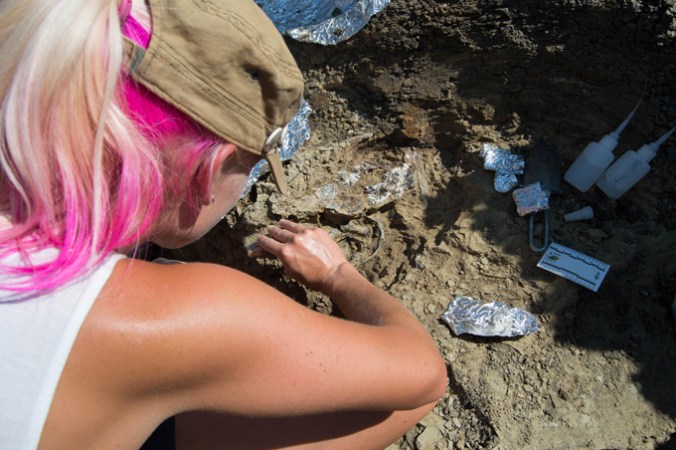The Age of Dinosaurs may have ended in springtime
Fossilized fish from North Dakota suggest when the Chicxulub asteroid strike devastated Earth

An asteroid impact off the coast of Mexico about 66 million years ago triggered devastating flooding at a site in North Dakota (illustrated). That dino-killing strike took place in the spring, a study suggests.
Joschua Knüppe
About 66 million years ago, a 10-kilometer-wide asteroid slammed into Earth and not long afterward, all nonbird dinosaurs, as well as many other species on land and in the sea, perished. Scientists don’t know the exact year of the strike, but researchers now say they have determined the impact’s season — springtime in the Northern Hemisphere.
The finding comes from a new analysis of the bones of ancient fish entombed at an extraordinary site dubbed Tanis in southwestern North Dakota, the researchers report February 23 in Nature.
Pinning down the season of the impact may help researchers explain the global pattern of survival of birds, small mammals and other creatures following the strike. For example, creatures that spend the winters in burrows underground would have emerged and been active during a Northern Hemisphere spring, rendering them especially vulnerable. By contrast, in a Southern Hemisphere autumn, these creatures probably would have been settling in for a season-long nap and perhaps were more protected.
Discovered in 2008, sediments at Tanis purportedly capture the flooding of a riverbed and other destruction that happened there in the immediate aftermath of the Chicxulub impact, which took place 3,000 kilometers away off the coast of what’s now Mexico’s Yucatán Peninsula (SN: 4/2/19; SN: 1/25/17). Previous work has also suggested that some of the fossilized Tanis fish have tiny spherules — solidified globs of molten and vaporized rock that had been flung skyward from the asteroid impact — stuck in their gills, a strong sign that the fish were still living and breathing as hell rained down on them.
“These creatures died incredibly close to the moment that debris was coming down,” says Thomas Holtz Jr., a vertebrate paleontologist at the University of Maryland in College Park who was not involved in the new study.
Some fish bones have features that can record seasonal and annual cycles of growth — akin to the growth rings in trees. These features typically include a thick band signifying vigorous bone growth, a thinner band that characterizes slow growth and a feature called a line of arrested growth that can denote wintertime or, sometimes, periods of famine or drought.
To figure out the season of the asteroid strike, Melanie During, a vertebrate paleontologist at Uppsala University in Sweden, and colleagues examined the jawbones of three paddlefish and bony spines from the pectoral fins of three sturgeons. The outermost layers of all six analyzed bones indicate rapid growth that hadn’t yet reached peak growth rates seen during previous years’ growth cycles, During says. That means that the last growth season recorded in the bones hadn’t yet reached its summertime peak at the time these fish died.

The regularity of the lines of arrested growth chronicled in the fish bones strongly suggests that the fish weren’t suffering from drought or famine when they died, During says. “By all indications, these fish were doing fine.” Taking the results together, the team pinpoints spring as the season of the dinosaurs’ demise, as least for Northern Hemisphere dinos.
“I really do think this is a solid story backed by strong evidence,” says Stephen Brusatte, a vertebrate paleontologist at the University of Edinburgh who was not involved in the new study. The asteroid impact “would have turned a season that is normally about growth and flowering and rebirth into a time of unbelievable fire and fury,” he notes.
Despite the passage of more than 66 million years, Holtz says, “it’s pretty amazing that we can look at Earth’s worst day and figure out the time of year it was.”







